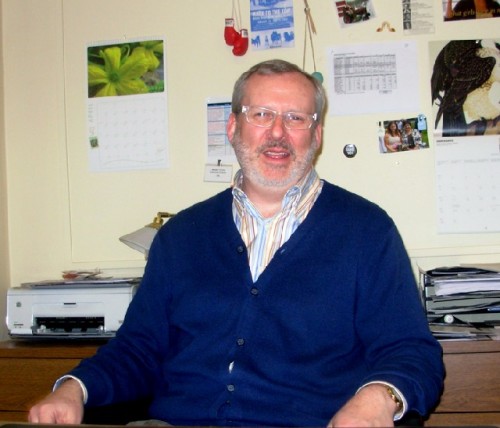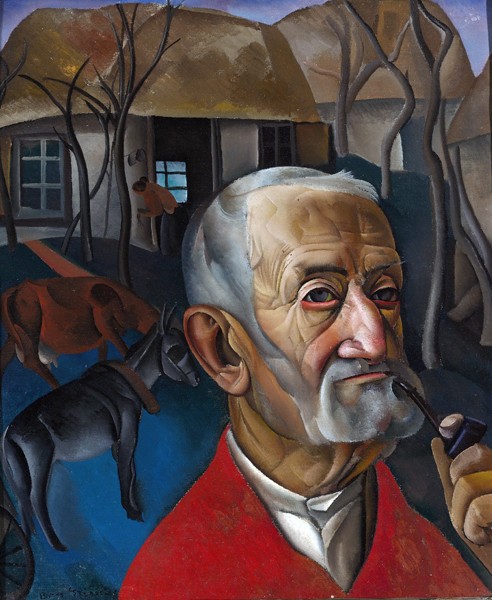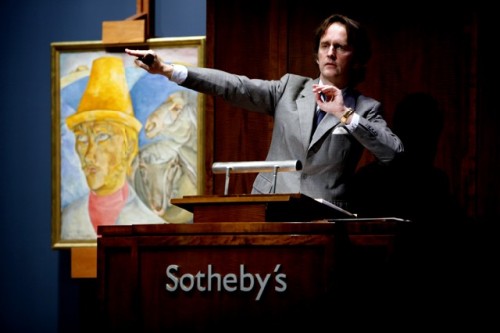Berkshire Museum in Pittsfield Prospering Despite Hard Times
Director Stuart Chase Discusses Recent Accomplishments
By: Charles Giuliano - Mar 29, 2009
Recently the 106 year old Berkshire Museum, in Pittsfield, Massachusetts completed the first two of three phases of renovation. There was also the windfall of the deaccession of three paintings by the Russian artist Boris Dimitrievich Grigoriev (1886-1939) which sold for $7 million at Sotheby's on November 3, 2008. The funds will be applied to the newly created Florence Keep and Josephine Crane Fund honoring the original donors of the paintings.
We met with the Berkshire Museum Director, Stuart Chase, who joined the institution four years ago, to discuss this remarkable progress. He was in an understandably upbeat mood which is unique during the currently miserable economy and its challenges for the arts.
Regarding the recently completed $10 million, capital campaign for renovation Chase was proud to comment that "We came in on time and under budget." But he also noted that the third phase which will take another $4-5 million has been placed on "indefinite hold." While the $7 million sale of paintings is a coup for the museum, by the guidelines of the American Association of Museums (AAM) and the State Attorney General, the money may not be applied to operating expenses.
Although sanguine in conveying mostly good news, and optimistic for the future of the museum and the Pittsfield community it resides in, there was also a cautionary note regarding challenges of the current economy. The annual operating budget of the museum is $2 million. For the next fiscal year he is making cuts to reduce it to $ 1.7 million. So far that has entailed eliminating six staff positions. Currently, the museum operates with the equivalent of 22 full time positions. The annual appeal has been reduced by some 50%. Half of operating revenue comes from earned income including admissions and memberships. The endowment, which has a number of restricted funds, is approximately $3 million. Accordingly, there is a narrow ratio between operating expenses and reserve funds. During a bad year there is not much to fall back on.
Overall, however, renovations have made the museum far more accessible and attractive to visitors. "For the first time in 106 years we have air conditioning (climate control) in the galleries" Chase said. That makes a big difference on a summer day. Although we didn't have that many sunny days last summer during what seemed like a never ending monsoon.
"We liked all that rainy weather last summer" Chase commented. "Rainy days are good for museums. Joe Thompson (Mass MoCA director) and I joke about that. We pray for rainy days. In an ideal situation it rains every morning until about three in the afternoon and clears in time for Tanglewood."
While Chase hopes to increase summer attendance it is during the winter and shoulder seasons that the Berkshire Museum outdraws other area museums. Largely this comes from the nature of the collection which includes an aquarium, natural history galleries, as well as fine arts collections and plaster casts of classical sculpture. This eclectic mix gives the museum its unique character and mandate and is a boon to schools and families. There are plenty of exhibits and activities for the kids as well as attractions for adults including special exhibitions and the Little Cinema which is enjoying its 59th year. The theater averages 80 visitors each night and screens films not offered in the malls and megalexes.
Of course, we wanted to know how the museum came to sell those Russian paintings? Chase enjoys telling that remarkable story. "I am an object focused individual," he said. "So when I joined the museum I wanted to see what we had in the permanent collection. The paintings are mounted on pull out racks so I started looking through them. We also had a grant at the time from the Institute of Museum Library Services (IMLS) to survey and catalogue the collection which also entailed appraisals and studies by art historians."
While going through the racks Chase came upon three Russian works that even longstanding staff members seemed to know nothing about. There were no records of their ever being shown other than shortly after they were donated in 1948. The works did not relate to any of the strengths of the collection so it was unlikely that they would be shown in the future. But they intrigued Chase who initially felt that they reminded him of 20th century American regionalist works. His instinct was that the works might be valuable.
One of the appraisers evaluating the collection as a part of the IMLS grant was Alan Fausel. He is a regular on the PBS's "Antiques Roadshow" and in general sees hundreds of works on a regular basis. "When he saw the three Russian paintings he was slightly dismissive at first" Chase recalled. "The first estimate was that, combined, they might be worth a million dollars. By then the market for Russian art was heating up fueled by the booming Russian economy. I began looking around and felt they may be worth more than that. I called Sonya Bekkerman, a senior vice president, and head of the Department of Russian Paintings for Sotheby's."
Bekkerman is a graduate of Williams College and has roots in the Berkshires. When Chase contacted her and related what they had discovered the initial comment was "What are you doing in three hours?" While she didn't exactly jump in a cab Berkermann arrived at the museum rather quickly. Chase recalled her reaction when first seeing the paintings. "In general those kinds of people are rather poker faced but she immediately became very excited. A couple of the works she identified through old black and white reproductions. It turns out that Grigoriev is one of the most sought after of the 20th century Russian artists particularly among Russian collectors."
After an agreement was reached between the museum and auction house Sotheby's made extensive efforts to market the works prior to its important fall sale. The paintings were sent to be viewed by potential buyers in London and Moscow. The works were thoroughly researched and conserved. There were full page ads in the New York Times as well as a catalogue devoted to the paintings. It generated the kind of publicity and marketing the museum could never afford. Sotheby's came to an estimate of $7 to 10 million. Much of this was a matter of timing and luck. Chase was told that 10 years ago, on a good day at auction, the three works might have sold for $100,000.
Compared to the recent scandal of the plan of Brandeis University to close the Rose Art Museum and sell its collection Chase described this as a "text book deaccession." The museum followed all of the ethical guidelines of the AAM. This included contacting the heirs of the donors of the works as well as extensive discussions with the Board of the museum and its collections committee. The money raised is mandated to be applied to acquisitions, as well as, the care and conservation of the collection.
Coming into the night of the auction, November 3, the eve of the national election, the economy was tanking. Some lots of the sale were withdrawn. The Grigoriev paintings "Shepherd of the Hills" "Man with Pipe" and "Binious (Pipe Players)" came to the block in the middle of the sale which, in general, was not going as anticipated. Some 20% of the lots did not make their reserves and were passed. The high point of the auction, preceding the Grigorievs, was reached when the 1916 "Suprematist Composition" by Kasimir Malevich sold for $60 million. Auctioneer Tobias Meyer, knocked down the three Grigoriev paintings at their low estimate of $7 million.
Just a month later the works may not have reached their reserve. Because of its status as a museum there were no fees or commissions entailed in the sale. The commission was paid by the buyers in compliance with a complex formula. The other good news is that because of normal delays the museum did not collect the money until some time after the sale. By then the markets had crashed to such an extent that the $7 million was wisely put into CDs in a number of Berkshire banks and are earning 3%. In this economy that's better than losing money. Also $7 million in real buying power is worth a lot more now than it was last November.
The $7 million has been added to a prior acquisition fund of $1.5 million. We asked Chase how he intended to use the money over time. His eyes lit up as there is something in the works that the museum is not ready to announce. In general, museums like to add to existing strengths in the collection which, in this case, includes Hudson River School paintings. If the right work at the right price is available Chase will interested. He would like to add to the Native American collection particularly Eastern Woodland materials. Chase is an authority on Native American art and artifacts and made a number of such acquisitions while director of the Rockwell Museum of Western Art in Corning, New York. He would also like to add to a significant photography collection. Other targeted areas include works by Berkshire based artists as well as the natural sciences. This summer the museum's aquarium will be renovated.
With all this good news how does the museum intend to get the word out? This summer, for the first time, there will be Berkshire based billboards. In general, however, marketing has been cut in line with other reductions across the board. The museum is not alone in facing concerns for the coming season in a terrible economy. There are regular meetings among the region's arts organizations and approaches to make the most cost effective bids for mutual services as well as marketing strategies.
While there is a lot of networking Chase expresses concerns for a number of arts organizations which are in the midst of capital campaigns to pay for bricks and mortar. This is a tough time to be paying off mortgages while also coming up with full schedules of programming. Most of the Berkshire arts organizations have announced ambitious plans for the coming season including the Colonial Theater just steps away from the Berkshire Museum.
When approached for the job of director, several years ago, Chase recalls being somewhat hesitant. But it was the mix of ambitious plans for Pittsfield that convinced him to make a commitment. He believes in Pittsfield and its strategies. He sees it as the center of the Berkshires with the largest population and the hub of business activity. The very fact that the museum is 106 years old says something about the institution, its roots, and commitment to the community. Yes there are challenges, but Chase and the Berkshire Museum, appear to be on a solid footing. Selling those three Russian paintings for $7 million was just icing on the cake.







